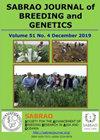由优良亲本基因型培育的有前途的旱稻杂交品系理化特性和食性
IF 1.7
Q3 PLANT SCIENCES
引用次数: 0
摘要
育种的最终目标是生产出对农业社区和最终用户有吸引力的高产品种,使其易于营销。因此,对大米的碾磨质量、理化性质和食用质量进行各种测试,以确定大米的整体质量,并评估潜在消费者的反应是至关重要的。本研究寻求12个由优良亲本基因型衍生的旱稻品系的完整稻米品质和消费者接受度。这项于2019年进行的研究分别对精米和熟米进行了碾磨和食用质量评估。磨粒质量分析表明,L-04、L-05和L-06系产中长粒,其余系产全长粒。L-02、L-09和L-12系为细长型,其余为中等型。所有旱稻品系的碾磨度(85% ~ 100%)、含水率(9.85% ~ 11.30%)、白垩米(0.06% ~ 1.59%)、黄米(0.21% ~ 1.77%)均达到国家标准(SNI 6128-2015)。品系L-03和L-05的稻米回收率分别为84.15%和84.76%,达到中一级品质标准。而L-01系和L-02系的HRR分别为66.24%和66.39%,均达到中- iii级标准。主成分分析(PCA)揭示了四个主要的物理化学特征,即铣削程度、长度、宽度和HRR。偏最小二乘回归(PLSR)分析显示,总体喜欢度是由四个描述性因素的相互作用决定的,主要是味道和质地。L-12系熟米(cv杂交)。与其他熟米样品相比,Inpago-8 × B11930F-TB-2)最受欢迎。本文章由计算机程序翻译,如有差异,请以英文原文为准。
PHYSICOCHEMICAL PROPERTIES AND EATING QUALITY OF PROMISING CROSSBRED UPLAND RICE LINES DEVELOPED FROM SUPERIOR PARENTAL GENOTYPES
The ultimate objective of breeding is to produce high-yielding cultivars that are fascinating to the farming community and end users, allowing for easy marketing. Therefore, it is crucial to conduct various tests on milling quality, physicochemical properties, and eating quality to determine the overall rice quality and evaluate the response of potential consumers. The presented study sought the complete rice quality and the consumer acceptance of 12 upland rice lines derived from superior parental genotypes. This research conducted in 2019 performed milling and eating quality assessments on milled and cooked rice, respectively. The milling quality analysis revealed that lines L-04, L-05, and L-06 produced middle-length grains, while others produced full-length grains. Rice from lines L-02, L-09, and L-12 were slender, while the rest were medium-shape. All upland rice lines also met the national standard (SNI 6128-2015) for milling degree (85%–100%), moisture content (9.85%–11.30%), chalky rice (0.06%–1.59%), and yellow rice (0.21%–1.77%). Lines L-03 and L-05 met the Medium-I quality standard with head rice recovery (HRR) values of 84.15% and 84.76%, respectively. However, lines L-01 and L-02 met the Medium-III standard with HRR values of 66.24% and 66.39%, separately. Principal Component Analysis (PCA) revealed four principal physicochemical characteristics, i.e., degree of milling, length, width, and HRR. Partial Least Squares Regression (PLSR) analysis displayed the overall liking as determined by the interaction of four descriptive factors, mostly taste and texture. Cooked rice of line L-12 (cross of cv. Inpago-8 × B11930F-TB-2) was the most liked compared with other cooked rice samples.
求助全文
通过发布文献求助,成功后即可免费获取论文全文。
去求助
来源期刊

Sabrao Journal of Breeding and Genetics
农林科学-奶制品与动物科学
CiteScore
1.90
自引率
50.00%
发文量
63
期刊介绍:
The SABRAO Journal of Breeding and Genetics is an international journal of plant breeding and genetics research and was first published in 1969. It is the official publication of the Society for the Advancement of Breeding Research in Asia and Oceania (SABRAO).
Its objectives are to: promote the international exchange of research information on plant breeding and genetics, by describing new research findings, or ideas of a basic or practical nature; and be a medium for the exchange of ideas and news regarding members of the Society.
The Journal gives priority to articles that are of direct relevance to plant breeders and with emphasis on the Asian region. Invited for publication are research articles, short communications, methods, reviews, commentaries, and opinion articles. Scientific contributions are refereed and edited to international standards.
The journal publishes articles for SABRAO members mainly. The Journal preferred strongly that at least one author should be a current member of the Society. Non-members may also publish in the journal.
 求助内容:
求助内容: 应助结果提醒方式:
应助结果提醒方式:


